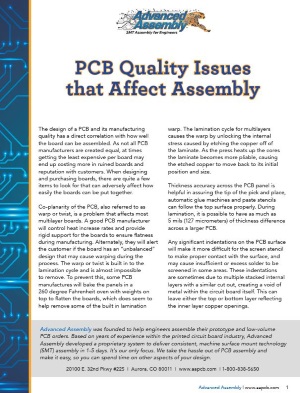
The design of a PCB and its manufacturing quality has a direct correlation with how well the board can be assembled. As not all PCB manufacturers are created equal, at times getting the least expensive per board may end up costing more in ruined boards and reputation with customers. When designing and purchasing boards, there are quite a few items to look for that can adversely affect how easily the boards can be put together.
Co-planarity of the PCB, also referred to as warp or twist, is a problem that affects most multilayer boards. A good PCB manufacturer will control heat increase rates and provide rigid support for the boards to ensure flatness during manufacturing. Alternately, they will alert the customer if the board has an “unbalanced” design that may cause warping during the process. The warp or twist is built in to the lamination cycle and is almost impossible to remove. To prevent this, some PCB manufactures will bake the panels in a 260 degree Fahrenheit oven with weights on top to flatten the boards, which does seem to help remove some of the built in lamination warp. The lamination cycle for multilayers causes the warp by unlocking the internal stress caused by etching the copper off of the laminate. As the press heats up the cores the laminate becomes more pliable, causing the etched copper to move back to its initial position and size.
Advertisement
Learn more about Advanced Assembly





